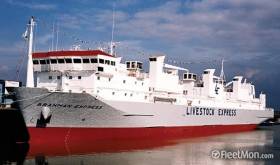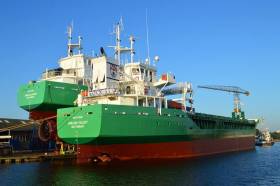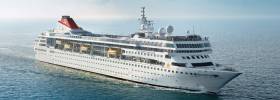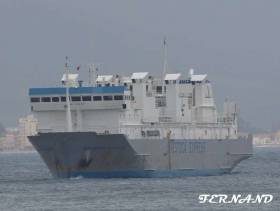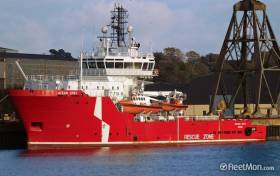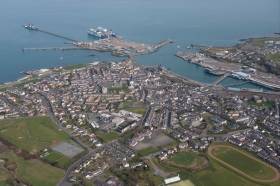Displaying items by tag: Ports & Shipping news
Shipping Review: Port Volumes Up 2%, Study Into Fenit Expansion & New Turkish Livestock Service
#ShippingReview - Jehan Ashmore reviews the shipping scene from among the following stories over the last fortnight.
The iShip Index published by the Irish Maritime Development Office (IMDO) recorded shipping and port volumes in the Republic rose by 2% in Q3 of 2016 compared to same period of 2015.
A €1 million feasibility study of the possible expansion of Fenit Harbour is to carried out next year by Kerry County Council.
In monitoring Irish Sea shipping movements Afloat.ie noted the livestock carrier Brahman Express had departed Greenore Port, Co. Louth bound for Turkey with 3,000 weanlings. This was the second of up to four such live export cattle shipments.
For much more on Irish Ports and relaletd news click here.
Foggy Launch Conditions of Arklow's Newest Dry-Cargo Vessel (See Video)
#FoggyLaunch - In particularly foggy conditions Arklow Shipping's newest dry-cargo vessel Arklow Valour was launched in the Netherlands yesterday, writes Jehan Ashmore.
The Dutch flagged 2,999 gross tonnage general cargsoship (yard No. 725) was launched sideways off the stocks at Royal Bodewes in Hoogezand. The newbuild is to serve ASL's Rotterdam based Arklow Shipping Nederland B.V. fleet.
It is also pleasing to report that the upgrading of Arklow Shipping's fleet includes Irish flagged vessels as Arklow Cape was launched last month at Ferus Smit’s Dutch yard in Westerbreok.
As for Arklow Valour this fourth sister is of 10 single-hold cargoships on order. The 85m long vessel is a Bodewes 5,150dwt Eco-Trader design or in terms of vessel naming theme is of the ‘V’ class series.
The newbuild has a straight stemmed bow likewise of the last completed sister Arklow Valley launched in July. This revised design compared to a previous trio of sisters as outlined below is also to provide an improved vision to the bow anchors when anchoring.
Representing the trio are Arklow Valiant, View and leadship Vale that feature a more distinctive pointed bow. This is to improve energy efficiency by deflecting wave impact and thus saving on fuel consumption.
These newbuilds are earning their keep as earlier this month Afloat noted Arklow Valley offshore of Dublin Bay. The vessel was bound for Drogheda Port having sailed from Terneuzen, Netherlands.
Charges for Cruiseships Waived by Rosslare Europort
#ChargesWaived - Shipping lines have been notified by Rosslare Harbour that it is to waive charges for cruise ships for 2017, 2018 and 2019. The initiative is to establish the south-east as a destination for what is Europe’s fastest growing tourism sector.
This follows the success of the arrival of the Fred Olsen Lines’ MS Braemar in July of this year, which was the first cruise ship to call to Rosslare in 20 years. Feedback from cruise passengers and crew was excellent, from the ease of arrangements with the Europort to the programme of activities and the warm welcome from representatives of Wexford County Council and Fáilte Ireland, supported by Visit Wexford
John Lynch, General Manager Rosslare Europort said “up to 400,000 tourists visited Ireland on cruises this year, and it is a sector which continues to grow rapidly. Europe-wide, the cruise industry contributed over €40 billion to European economies, supporting 350,000 jobs.
“We believe – and customers from MS Braemar agreed – that Wexford and the South-East provide a destination which would be an excellent inclusion in any cruise itinerary visiting Ireland. By waiving charges, and working with local authority and tourism colleagues on the Working Group I established to develop new cruise business for the Europort, we are confident we can build a consistent and sustainable business which will bring tourists, profile and, crucially, employment and income to the South-East.
“We are fortunate at Rosslare that not only do we have the capacity to operate as a busy commercial port, but we are also situated in an area of outstanding natural beauty and rich cultural heritage and I believe that there will be many more Cruise Ships that will want to explore the wonders of Wexford and the South East.
“Our waiving of charges is a first step – we want to establish long-term relationships with the many cruise line companies operating in Europe which will support the Europort and the region into the future.”
Since 2008, European cruise capacity has grown by 44%, a trend which shows no sign of abating.
Customers on the MS Braemar had availed of pre-arranged excursions throughout the Wexford Region including scenic drives and walks, and visits to Tintern Abbey, Wells House, Kilmore Quay, the Irish National Heritage Park and the Dunbrody Famine Ship in New Ross.
Cattleship Loads 3,000 Livestock Departs Greenore Port for Turkey
#CattleShip - In monitoring Irish Sea shipping movements Afloat.ie noted a livestock carrier that had departed Greenore Port, Co. Louth today is bound for Turkey, writes Jehan Ashmore.
The purpose built livestock carrier Brahman Express with a cattle capacity pen area of 4,758 m2 spread across five decks, had passed the Codling Bank buoy offshore of Wicklow Head this afternoon.
The Philippine-flagged vessel built in 2002 and operated by Livestock Express B.V. based in Breda, The Netherlands is part of the Vroon Group B.V. They have a diverse fleet of around 200 vessels.
It transpires that the 133m long Brahman Express according to The Irish FarmersJournal.ie had arrived back in Greenore Port on Monday evening. The 7,700 gross tonnage vessel was to load a second fresh shipment of live export cattle.
The live exporter, Viastar added the Farmers Journal writing on Monday, had expected to load 3,000 weanlings on the ship this week for the Turkish market. Viastar is expected to fill two further shipments to Turkey this year under a contract running until the end of December.
Afloat adds that Brahman Express which when in ballast is capable of 16 knots, is bound for the Turkish port of Mersin.
Study to Explore Possible Expansion of Fenit Harbour
#FenitExpansion? - A feasibility study to explore the possible expansion of Fenit Harbour is to carried out next year according to Radio Kerry.
Kerry County Council will spend almost €1 million in 2017 on the operation and promotion of the harbour. This includes staff costs and maintenance of the pier, marina and lighthouse.
The council says the development of an assembly hall and office by Liebherr Container Cranes consolidates the company’s position in Fenit Harbour.
An example of the crane export trade Afloat.ie reported in 2012 of what was then believed to be the largest ever ship to dock at the port the heavylift ship HHL Valparasio (2010/17,634grt).
The Liberian flagged vessel called to the south-west port to load a pair of ship-to-shore container cranes bound for the US.
Dublin’s ‘London’ Landings: Post-Brexit Banks Be ‘Capital’ Boost to Liffey Scene?
#LiffeyPotential – Post-Brexit potentially poses an exodus of UK banks relocating from London to the EU and notably Dublin’s financial Docklands, where the Liffey flows through with barely any river-traffic compared to the Thames, writes Jehan Ashmore.
Since the Brexit vote on the EU referendum, property agents in Dublin have had a 30% increase on inquiries from UK firms looking to relocate. This is according to a joint report by the Royal Institution of Chartered Surveyors and the Society of Chartered Surveyors Ireland. Potentially such an influx of thousands of financial services employees could further boost the Docklands quarter with spin offs leading to new river-based operations / floating businesses. The increased financial flight of capital could also favour related corporate sponsorship of tallships and powerboating races.
Among the major high-rise Docklands developments underway is Dublin Landings, an impressive 1 million sq foot central north riverside project also at Spenser Dock. This is a mixed development of offices, apartments and retails space includes the new headquarters of the Central Bank originally destined to be that for Anglo Irish Bank no less!
There are also plans at Spenser Dock for the DART Underground, this would be something of a Dublin version of London’s Canary Wharf Docklands. Passing this major financial district in June was RMS St. Helena heading to the UK capital, the first visit ever visit to her homeport of registry, yet notably having taken place after the 'RMS' made a unique call to Dublin Port 21 years previously on the River Liffey.
As reported previously, Thames commuter-river bus operator MNBA Thames Clippers whose 15 catamarans will carry four million customers by the end of 2016. The operator MNBA do a lot more as they are also one of the UK's largest credit card issuers. Obviously there is considerably less demand for a Liffey commuter service, given the bridges built and since the Celtic Tiger and the extension of the LUAS Red Line to the Point. A commuter service however did exist in the form of the far more humble Liffey Ferry operation when compared to the busy Thames scene.
It was during the credit crunch crash that Liffey Ferry with the support of the then Dublin Docklands Development Authority (DDDA) ran a river-taxi shuttle service between bank to bank… pardon the pun. The river-taxi RIB named Liffey Flyer was aptly yellow in colour like its New York land-based counterpart. The three-minute hop between Sir John Rogersons Quay and the North Wall. The DDDA was transferred to Dublin City Council and Afloat at another stage will be examining DCC’s North Lotts and Grand Canal Dock Strategic Development Zone (SDZ) and its relationship with the River Liffey. The underutilised water thoroughfare and Grand Canal Basin is in stark contrast to some other EU capitals as echoed by Docklands Business Forum.
Outside of peak times, Liffey Ferry attracted tourists as it was a short-cut in which having personally availed to reach the working port of Dublin beyond the East-Link Lift Toll Bridge now named the Tom Clarke Bridge. There are currently plans at the river crossing to ‘reorder’ this area of waterfront where small vessels among them cruiseships transit through the lift-bridge to reach city-centre quays. The ‘old’ Liffey ferry whose origins date to the 14th century, was operated by Dublin Corporation’s own fleet that mostly served dockers until the ferry was made redundant in 1984 with the opening of the East-Link Bridge.
In regard to the Liffey Ferry of the DDDA this only operated for about two years and was always a stop-gap measure in advance of the opening in 2009 of the new Samuel Beckett Bridge, part of the Docklands regeneration vision. The swing-bridge was ‘imported’ having already been completed in the Netherlands from where the structure was towed on a barge and ‘sailed’ through the East-Link bridge as it was known then.
At present the Liffey has only one operator, albeit the ‘tourist-excursion’ year-round service of Dublin Discovered Boat Tours. They operate a 48 seat sight-seeing craft, Spirit of Docklands, custom-built for the DDDA when launched in Finland for Liffey River Cruises. The ‘Spirit’ plies between Bachelors Walk upriver to the Old Ha’penny Bridge and downriver to the 3Arena, formerly the O2 and before that the Point Theatre. As previously covered, the Liffey Line ran during the mid-1990’s a similar shuttle river-bus and night-time service for theatre patrons from City Quay using a former Shannon based water-bus craft.
On the North Wall is berthed the Dublin 1962 built veteran M.V. Cill Airne, a former transatlantic liner tender based in Cobh which has been a ‘resident’ of the Dublin Docklands for almost a decade. The static venue with restaurants and bars on board the 500grt vessel is located at a prime position close to the Convention Centre, host of a historic reception for Queen Elizabeth II in 2011.
Also gracing the northside is the Jeanie Johnston, a replica of a 19th century barque which tells the story of Irish emigrants fleeing the famine to start a new life in America. The floating museum tallship is undergoing maintenance but is scheduled to reopen to visitors next month.
Not strictly a Liffey operator, Dublin Bay Cruises in recent years began seasonal ‘summer’ excursions also from City Quay on a network linking Howth and Dun Laoghaire Harbours. St. Bridget is to resume duties also next month albeit in the context of ‘festive’ river party cruises.
National Commemoration Service for Irish Seafarers to Be Held in Dublin, Dun Laoghaire and Cork
#Commemorations – The annual National Commemoration Service for Irish Seafarers in Dublin on Sunday, 20th November will notably be followed on the same day with an Ecumenical Service held in the National Maritime Museum, Dun Laoghaire. The annual service is hosted by the Maritime Institute of Ireland which this year marks a 75th anniversary.
As referred above the Service for seafarers will be held in the capital at 12:00 hours at the City Quay Memorial to Irish Seafarer's which is dedicated to those lost at sea in WW2. Also notable this year is the centenary period of WW1 in which this will add to the importance in recognising the enormity of both wars and the loss of life from Irish merchant ships. The memorial is located downriver nearby to Tara Street DART Station.
War-time Irish shipping companies ‘House Flags’ along with the banner of the Maritime Institute of Ireland will be paraded by the Sea Scouts. Wreaths will be laid at the memorial. In addition to addresses made the wreaths will be brought into Dublin Bay and floated on these waters. Traditionally this honour is performed on a rotational basis between the tugs of the Dublin Port Company, Naval Service vessels or a R.N.L.I. lifeboat.
Dun Laoghaire Ecumenical Service: Sunday 20th November
On completion of ceremonial proceedings in Dublin (as above) the company will depart that afternoon of Sunday 20th November for the National Maritime Museum of Ireland in Dun Laoghaire. At 14:00hrs an ecumenical service is to be held in the museum housed in the former Church of Ireland Mariner’s Church. The museum is located on Haigh Terrace opposite the Lexicon Library.
The service is to be conducted Fr. Pat Mernagh CF, army chaplain and Rev. William Black port chaplain. All are welcome to attend and following proceedings refreshments will be served.
Cork Ecumenical Service: Sunday 27th November
On the following weekend, the M.I.I.’s annual Cork Ecumenical Service will be held in the Port of Cork Office at 12:00 hrs, Sunday 27th November. The venue of the historic building on Custom House Street is located downriver from the nearby Cork City Bus Eireann station.
Likewise of the services held in Co. Dublin of the previous weekend, anyone who has an interest in the sea are very welcome to attend.
75th Anniversary of Maritime Institute of Ireland
The 75th anniversary of the Maritime Institute of Ireland (Foras Muiridhe na h-Eireann) was marked last month on 31st October 1941, one of the most critical moments in this country’s history.
Some of the founders and earliest supporters had been trying to impress on the general public and on government for at least the previous five years, in particular its real founder and longest serving President, Colonel Anthony Lawlor, that if, as seemed more and more inevitable, a catastrophic European war were to break out, Ireland would very quickly be in crisis. While we had very good reason to declare ourselves neutral, nobody in the highest position of critical responsibility had taken the trouble to ensure how a small neutral island which depended on the importation of vital food and other supplies was going to survive when the ships, mainly owned by non-nationals that carried our vital imports and valuable exports were no longer avail-able. Yet, by 1942, this was precisely what had happened and starvation and economic collapse were all too visible on the horizon to even the dumbest politicians.
The current role of the M.I.I. is to foster an appreciation of our maritime heritage. To that end asides hosting and supporting commemorations, they operate the maritime museum, host lectures, issue newsletters, maintain a library and promote and conduct research.
Mainport Group Acquire Supply Support Vessel for Kinsale Gas Field
#MainportKinsale - Afloat first reported of Ocean Spey operating at the Kinsale Gas Field last Wednesday and now it can be confirmed the standby supply support vessel is to be reflagged under the Irish tricolour having been acquired by Mainport Group, writes Jehan Ashmore.
The 1,864 tonnes Ocean Spey had been based at Aberdeen (see photo) the 'oil' capital of Scotland until she sailed six weeks ago to Cork Harbour, homeport of the Mainport Group.
The 66m long Ocean Spey has yet to be given a customary company ‘tree’ suffix themed name i.e. Mainport Cedar (harking back to the Irish Shipping Ltd fleet era). The vessel is currently offshore of the pair of gas rig platforms, Kinsale Alpha and Bravo some 50kms offshore of the Cork coastline.
Ocean Spey is a Norwegian 2000 year built vessel with anchor handling capacity that replaced Mainport’s standby supply ship, Pearl. This 1,579 grt vessel has served the Kinsale Gasfield since 1985.
Mainport provides the newcomer, Ocean Spey to serve at the PSE Kinsale GasField offshore gas installation which has changed hands since gas extraction began in the late 1970’s. A Mainport subsidiary, Seahorse having then begun operations with albeit smaller vessels the Seahorse Minder and Seahorse Supplier.
Some three weeks ago, Pearl was stood down and destored at her usual berth at Ringaskiddy. The 65m vessel then relocated the short distance across Cork Harbour to where the vessel remains alongside Cork Dockyard. There was an interim period when Mainport deployed Celtic Isle of subsidiary Celtic Tugs at the gasfield prior to the introduction of Ocean Spey.
Also recently in Cork Harbour, Mainport Cedar, as previously reported on Afloat back in 2014, was the first of a pair of newbuild Malaysian built seismic-survey vessels delivered to Mainport of the previous year. Notably earlier this year the vessel was detained during a charter for a UN World Food Programme mission to war-torn Yemen.
This was Mainport Cedar's first ever call to Cork Harbour and this was due to maintenance requirements in between sailing from the North Sea and the Gulf of Mexico. The work carried out took place at Cork Dockyard in advance of a contract to a seismic company for the oil sector in the Gulf of Mexico as also featured in last Friday’s Seacapes.
The seismic-survey vessel has since departed Cork Harbour on the North Altantic repositioning voyage.
ICG Revenue In Container & Terminal Division Rise 5.7% On Previous Year
#LoLoTrade - Irish Continental Group (ICG) total revenue in Container (Lo-Lo) and Terminal Division recorded in the period 1 January to 31 October 2016 amounted to €105.0 million, an increase of 5.7% on the previous year.
For the year to 5 November container freight volumes shipped were up 5.3% on the previous year at 260,900*TEU , with the rate of growth slowing to 2.5% in the period since 30 June reflecting market trends.
Units handled at our terminals in Dublin and Belfast increased 18.8% year on year to 245,300 lifts, principally attributable to increased throughput at the Belfast terminal in the first half of the year. This reflects the award of the concession to operate the larger combined container terminal at the Belfast Victoria Terminal 3 which commenced in June of the prior year. In the period since 30 June with comparable operations the terminal throughput was 2.2% lower reflecting changes in customer schedules.
The effect of a weaker Sterling is not significant in the Container and Terminal Division due to the low level of net Sterling exposure.
*TEU twenty foot equivalent container units
Customs Checks at Holyhead Port Will be Brought Back in After Brexit
#BrexitPorts - The Welsh First Minister has said customs checkpoints at Holyhead, the north Wales ferryport on Anglesea will have to be set up ahead of Britain leaving the EU.
The Daily Post writes that while there are currently ad hoc checks on lorries and vehicles coming through the port from Ireland and other EU countries, they are not a permanent feature. But once Brexit happens and Britain quits the European Union, there will need to be customs officials there on a permanent basis.
However, the Welsh Minister Carwyn Jones,speaking exclusively to the Daily Post, said anything further - such introducing full border controls between the UK and Ireland, would be chaos for North Wales. He said: “We are going to see customs back in Holyhead anyway ... but if you had passport control in Holyhead then you are going to see queues all across the island.”
For more click here and including previous coverage of the implications facing Stena Line (which sail to Dublin Port) which they say Brexit will have a 'completely new situation'.



























